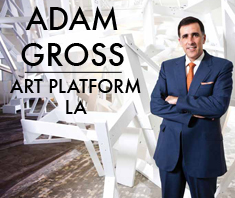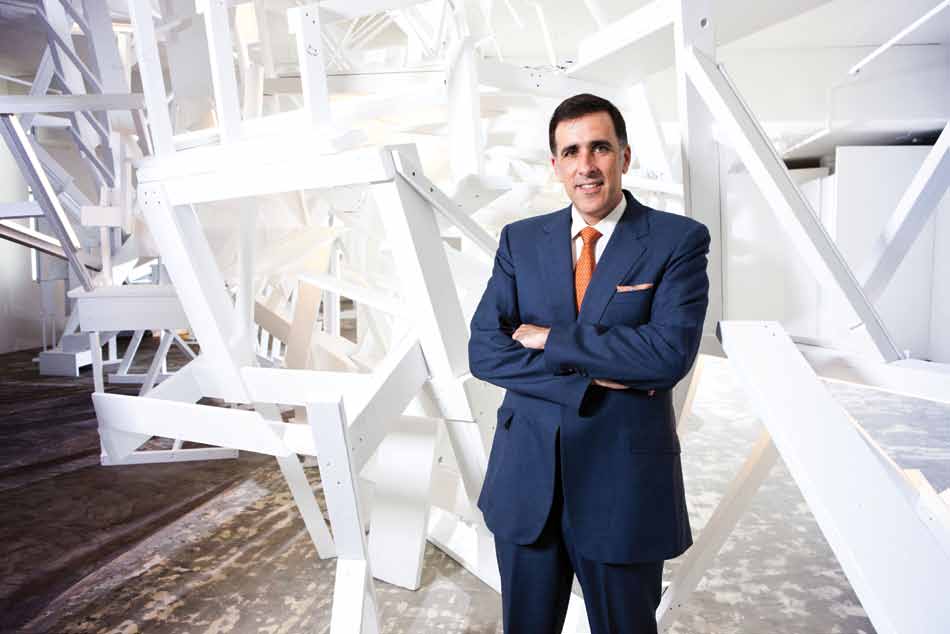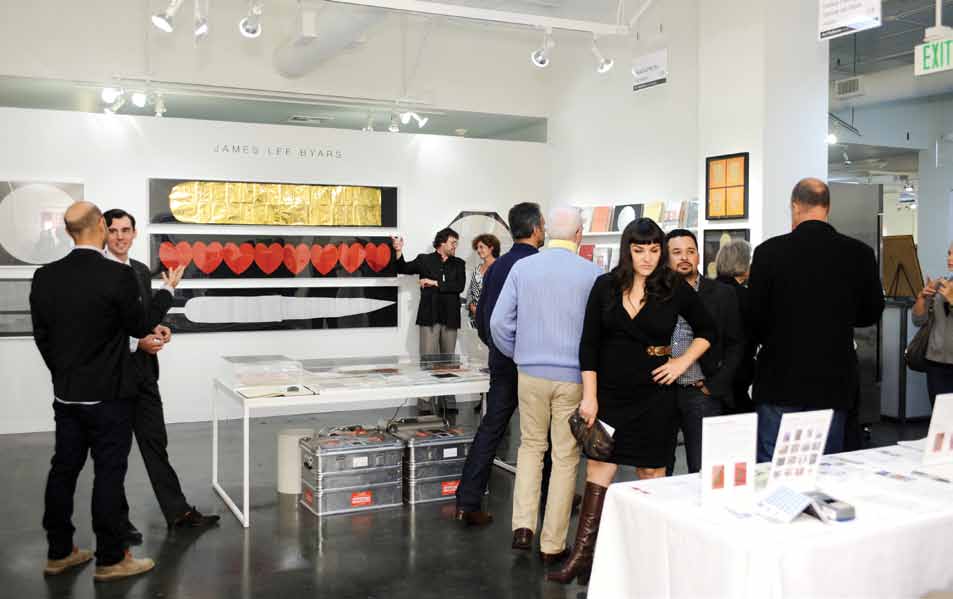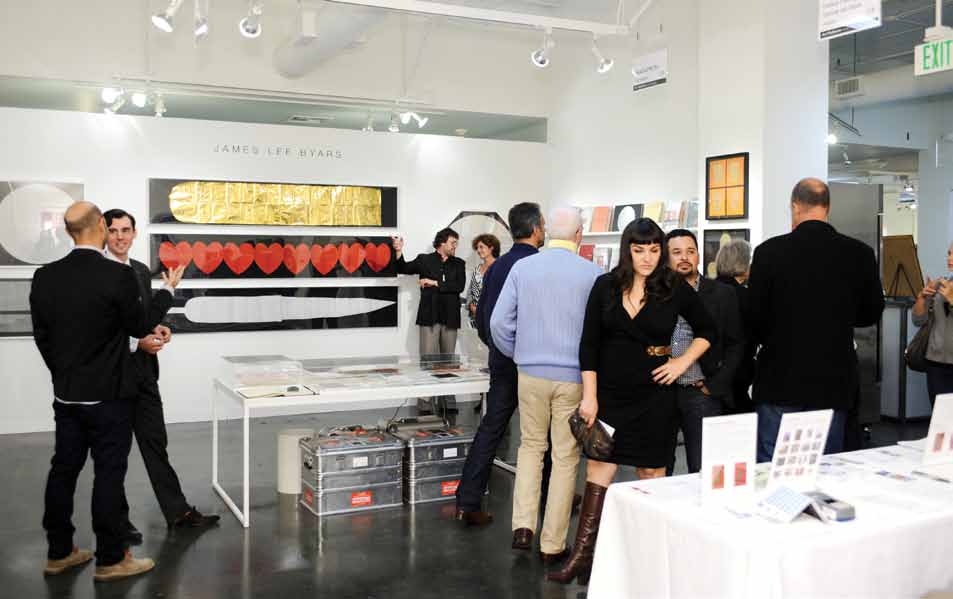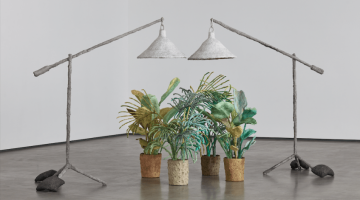Adam Gross
(Executive Director of Art Platform LA)
Interviewed by Gregory Ito
(from print issue 10)
I’m here with Adam Gross at the Los Angeles County Museum of Art (LACMA) and we’re here to discuss the necessary measures made by institutions like the MOCA to fund their programming, and the future of the Los Angeles art market. Adam, tell us some history about yourself before your previous position at MOCA and your current position with Art Platform.
Well, I was born and raised in Los Angeles and I left here after attending UCLA for an undergraduate degree in art history and finance. I was thinking I wouldn’t be coming back to LA because it didn’t seem that interesting to me at that point. I lived in Europe, New York, etc., then came back in the mid 90’s and was blown away. I was so surprised at what had happened in the few years I had been gone, and it really seemed that LA had found a new sense of cultural identity and cultural vitality. I felt like I wanted to be a part of that. At that point I was working in the world of finance, and the logic was that I would make my money in the financial side and then spend my money on the art side. But I quickly realized that what made me happy was to completely immerse myself in the arts and culture.
So I did finance, and ran a small gallery in Los Angeles for several years. It was called the Kantor Gallery, run by a guy named Niels Kantor. Niels was the son of a large art dealing family in Los Angeles, his parents were a couple by the name of Paul Kantor and Ulrika Kantor, who brought Diebenkorn to Los Angeles for the first time.
It was a great opportunity to learn about showing young emerging artists, and we would show everything from young, unknown artists to Picasso. I really enjoyed that experience. I got my masters in art history from UCLA, which has a great art history program, and after that worked at Butterfields when it was owned by Ebay.
So I was there for several years and left in 2002 to become a consultant. I worked with corporations, with private collectors, and was a private dealer as well. That was a great exercise and great experience; seeing how these corporations worked, seeing how collectors worked and how they collected on a more [concerted] level, as opposed to the gallery or auction side.
One day the opportunity came to run “individual giving” at MOCA, which were major gifts and managing all their major donors. I had long been a fan of MOCA’s program, of MOCA’s mission, of what they had done, and what they meant to contemporary art both locally and internationally. When this opportunity came up, to be part of this bigger team and to be part of the team at a capacity where I knew I could make a difference, I knew it was what I needed to do. I had founded a nonprofit [PHARMAKA] that was in downtown Los Angeles, and had been on the boards of smaller nonprofits as well as a lot of volunteer work for nonprofits on the board level. Whether I knew it or not, I was giving myself the experience I needed to be able to go into a nonprofit environment and at least be informed about the issues that were at stake. MOCA had its own specific set of issues and its own specific focus, but nonprofit development, nonprofit fundraising, it’s really about relationship building. It’s about building around the mission, around the program. Being born and raised in Los Angeles, I knew the program. I was familiar with issues surrounding nonprofits and ultimately my business background, I thought, gave me an interesting perspective as well.
What was your title at MOCA?
My official title was Associate Director of Development for Individual Giving, the acronym being ADD, which is what it felt like my life was, Attention Deficit Disorder. I was managing a portfolio of 500 collectors and donors at any given time, not to mention all the people I was cultivating.
So these are relationships that already existed at MOCA as well as new ones you were cultivating?
And MOCA, being an institution that’s over thirty years old, had a lot of relationships that had gone to fallow, had sort of drifted apart, so it was really interesting learning about the history of the institution. MOCA does have a very unique history in that it wasn’t started by the city. It wasn’t started by the government and it wasn’t started by a private individual, it was started by the people. The original mandate for MOCA was that the city said, ‘we’ll give you space, but you just have to raise ten to thirteen million dollars, and you have to do it from a broad base of people,’ and that’s what they did. They literally raised that money $10,000 at a time, and were able to come back to the city with: ‘here’s our endowment, now let’s build this museum.’ So it was interesting because there was such a broad base of what they call “founders” that were part of this. Not, ‘we built the building, now we want you to be a founder.’ It was, ‘we have no building, but we have an idea, now we want you to buy into that idea.’ Imagine how difficult it is to raise the money on an idea. It’s like a business plan except that it’s a nonprofit. So there’s no profit. No one is going to make their money back. You’re making an angel-investment.
Those people are still, not all of them, but many of them are still involved and are remarkably passionate about it. The great thing is that you start talking to them and they start talking to their kids, and then their grandkids that are involved as well. It’s nice seeing that kind of longevity because it’s something that we miss in Los Angeles. You have it in San Francisco and in many other large metropolises, but we don’t have a sense of civic and cultural philanthropy in Los Angeles. There isn’t that tradition of second and third generation families that have been supportive and continue to be supportive.
LA tends to be filled with people who’ve made their money here or brought their wealth here because they made it somewhere else and are retiring here, or it’s one of their homes. So we don’t have that same kind of tradition. MOCA was remarkably challenging because it gets very little, if any of its budget subsidized by the city or state or federal government on an annual basis. MOCA would get grants from time to time, but it’s not like, LACMA [Los Angeles County Museum of Art] which is funded by the county. The Hammer is part of UCLA so it has its own funding. At MOCA every year you would look at your budget and say, ‘okay, let’s raise twenty million dollars.’ And we had to do it every single year, from scratch.
How many people were on your team?
Well, in the development department there were probably, at its height, around ten, give or take. And then we pulled it back because of budgetary reasons.
I find it amazing that you and a team of ten can raise twenty million plus dollars a year.
Well to put it in perspective, LACMA has a sixty million dollar budget and it has maybe sixty people in its development department. A big portion of their funding comes from the county, which MOCA doesn’t have, making it a relatively unique environment for fund raising.
So besides the funding going towards the exhibitions and the build out/ maintenance and staff fees, where does it go?
Well, once you start digging into those budgets, it’s remarkable what it takes to build a museum, to sustain a museum, to do good and interesting programming. That was one of the things I always appreciated at MOCA, was that it was typically willing to do big, crazy idea shows. Like right now it has a show of [Land] Art. When I was helping to raise money for this show, we found out very quickly during developement that there had never been a survey show or a Land Art retrospective. Why? Because you almost can’t do it. Land art exists outside in the world, so if you do something in a museum it’s photos, it’s ephemera, it’s relics, and it’s ideas, which do not make the most exciting exhibition. But MOCA was willing to do that.
MOCA also worked on a feminist art exhibition called Wack!, which was frankly an encyclopedic exhibition on feminist art from 1965 to 1980. The book is literally an encyclopedia, the catalog. And it was an amazingly important show, and I think it had a hundred artists, but whatever it was, it was insane how unruly trying to wrap your head around this idea was. It took them eight years of development. Most museums would not fund something that was going to take eight years of development. There’s a beautiful piece that’s going to be installed, a piece by Michael Heizer, which is literally a hundred feet from where we’re sitting right now, at LACMA. That’s a piece of Land Art. You can see it, and it’s visceral. But at MOCA, you’re looking at ideas and sketches for the spiral jetty, and that was one of the things that I really appreciated about MOCA’s program.
So the curators would develop an idea and then you and your team would use it as leverage for specific collectors and other individuals involved in that field, particular movement, artists, etc?
Raising money for specific exhibitions was a very sincere way of being able to approach people that were involved with MOCA, had been involved with MOCA or that you knew were involved with an artist, idea, type of art or specific movement. We would help make it possible. It’s interesting what we do, but the real heroes in this are the exhibition are the people, it’s the curators that are working on ideas and it’s the director that’s raising the real big money. The thing that made me an effective fundraiser was that I could conceptually talk about the work and get excited about it. It’s in that excitement that you’re able to raise funds.
And the idea comes first, right?
The idea comes from the curator and the director and then in their intellectual crucible of all these curators sitting together, they refine that idea. They refine that idea until it’s decided, ‘we have a show here.’ When we have identified the pieces that we want, or we’ve identified a general direction of the show, they will bring in, let’s say 75% done basically, because there’s always serendipity. They will then bring in the development department and we’ll go: ‘oh, great, you’re doing a Land Art show, okay, let’s look at every gallery that showed land art. Now let’s look at every collector that owns land art, or that sponsored or published land art.’ Then we’ll also look at foundations and we’ll start narrowing it down to foundations that either have a component of the exhibition that feeds into what they’re doing, or maybe there’s a relationship that they have with them and we know that they would be interested in supporting that exhibition.
We do the same thing with corporations. So with Land Art we might say, ‘hey, Gensler,’ which is a company that’s installing a Michael Heizer piece here, ‘let’s go talk to Gensler. Maybe Gensler is interested in supporting the piece.’ You’re going to go to Bank of America and Wells Fargo. You’ll go to Coca-Cola and different companies, but then you might think: ‘wow, maybe Caterpillar would be interested in the Land Art, right? Maybe companies that are power companies that own the land around Robert Smithson’s spiral jetty, maybe they would be interested in doing this.’ And you kind of just keep working through this network of people and in the end you’re trying to raise funds to support this program.
But what you’re also doing, which is hard to quantify, is spreading the word. Before a press release is written and before it gets up onto your website, you are walking around with a little portfolio of information and images and curatorial statements, etc. You are sharing it with people that are already engaged. You might be talking to people who have no idea about the exhibition that you’re about to launch, or you might be talking to people who are already lending work to the exhibition. There’s no obligation, one does not beget the other, but I used to have collectors that told me straight up, ‘look Adam, if you want to get money from me, ask me for exhibition support when I am lending something to the show. Or if I’m a big holder of that artist’s work, even if I’m not lending to the show, that’s when I will be interested and be able to lend.’
Have there ever been moments where an exhibition never made it to the public because there weren’t enough funds raised?
Well, that’s a good question. I’m sure there are examples of that. But typically you wouldn’t hear about those examples because maybe your preliminary fund raising got no traction and it didn’t work out. Otherwise—the idea is generally that you do your blockbuster show, you do your Warhol show or your Basquiat show and you get a quarter million people in the door and you raise your revenue and you raise everything by X amount, and that helps you pay for the show that is under-funded. Just like a gallery will do your secondary market sales, meaning like your Warhols and your Lichtensteins, and you make a lot of money doing those and that helps pay for your primary market and your emerging artist program. Or you do your Rouchet exhibition, it makes you X amount of dollars, which then subsidizes all your young emerging exhibitions.
Let’s talk about what you’re doing currently with Art Platform in Los Angeles, relative to the Armory Show in New York.
I was approached, I guess it was in 2010, by the Armory Show. They had been looking for several years at opening a fair in Los Angeles. I had heard about their efforts and I think the timing was just never right, specifically with 2007 and 2008, you know, the slow down in the economy. By 2010 they felt that the timing was starting to go into the right direction. Frankly, I hadn’t really given a lot of thought towards working for an art fair, and I was enjoying the work I was doing at MOCA. I was good at the work I was doing there and I was working with a remarkable team of people.
When I really thought about it I realized why I was working with MOCA, and it was a great institution, but it was also what the institution represented, which was a way to bring the arts to a broad audience. I had worked at galleries that had brought it to a specific audience, and I brought it to a museum, that speaks to a different audience. When I started thinking about what an art fair could do, I realized that an art fair can hold a very unique place in a culture or a civic environment, in that it’s an easy way for people to see a lot of art very quickly. It’s less intimidating and typically more fun than going to a museum or a gallery, and you can go see fifty to a hundred galleries in one day, and talk to the owner of the gallery, talk to the director of the gallery, the prices are right there—it’s a totally different experience, because you get a lot of material under one roof.
I want the viewers and the visitors to have a good experience, but I also want the gallerist to have a good experience and feel like they were able to have meaningful conversations with collectors. What we’re talking about, as I mentioned, was really expanding the audience and there’s something very easy about going to an art fair. You go, you pay your entrance fee, you can have a drink, you can have lunch, you can walk around, you can sit in the lounge, you can go see a lecture, so it’s not like going to a museum or going to try and visit galleries. It’s easy, it’s fun, it’s efficient.
So that was why I really even entertained doing this, because I felt like it really fit into the broader goal that I had, which was ultimately expanding the audience for art and culture in Los Angeles. Because like we started with, LA does not have a tradition of philanthropy. What LA does have is a remarkable concentration of wealth. There are a lot of people here who are leaders of industry, as well as the entertainment industry. There are a lot of people here working in a creative industry, earning wealth in that industry, yet who have not been introduced to the other creative community in LA, which is the art community. And that’s important.
The sort of high-net-worth guys and the big, we are helping create that kind of relationship between art and people at that end of the pyramid. For instance MOCA every year raises a million dollars just on its membership. This is $50, $100 members, you know? So it’s important that you have those people. And I think that an art fair can have a nice broad appeal where you can go see a lot of art and if you don’t have the money to buy any, not feel intimidated. When you buy a book and a postcard and you do your thing and you have lunch and have a great art experience, or you do have the capacity to buy that Anish Kapoor or that Dave Muller or that Jennifer Steinkamp, or whoever, it does become a bigger investment. I want to appeal to all those audiences ultimately.
That’s how your background at MOCA fits in, you know? You’re doing a service to the public to be able to see all these art works, but you’re also cultivating relationships with collectors who buy work from the galleries.
That’s a good point, because I didn’t think of it that way. I thought of it more as: I was cultivating relationships with these collectors and philanthropists, and you sort of forget at a certain point that you’re raising that money so the doors can stay open for the other million people that don’t own an Ellsworth Kelly painting.
Can you talk more about the relationship of Art Platform and the Armory Show.
I had the great fortune of working with the Armory show. There was a gentleman named Paul Morris. He was one of the founders of the Armory Show who is still the founding director and works with our parent company, MMPI, to manage the art fairs, but it was he who approached me about partnering with the Armory show, working with MMPI, and tapping into the resources, the expertise, the reputation, the sort of marketing the brand of the Armory show to develop something unique and special to Los Angeles. What ended up becoming a virtue and became really appealing about this as well was that they weren’t interested in dropping the Armory show onto Los Angeles. This is not called the Armory Show Los Angeles.
It’s a separate identity?
Yes, and what they recognized was that LA does have a unique identity and that it’s experiencing a unique moment in its history right now. That the issues and some of the challenges that surround doing an art fair or any large event in Los Angeles are unique to LA. By taking the Armory show and sort of dropping that model on LA, which is a model that was developed in and for New York over nearly twenty years, I mean, like really organically coming together, dropping that on LA would be disingenuous. You would set up a level of expectation that we wouldn’t be able to meet because this is a different environment. There are different things happening here, and we have to be sensitive to that.
How did you tune the fair to fit a city like Los Angeles?
Well, what we’ve realized is that when we stood back and looked at what made LA a great art town, the things that really distinguish us, I mean, we have great museums, we’re in one now at LACMA, we have great collectors, we have great gallerists and great galleries, but the thing that really distinguishes LA right now are the artists. There are more great artists doing interesting things in LA than I think anywhere else, and I think we have some of the best art schools in the world that are pumping out new batches of artists every year, and many of them are staying here. So one of the things that we tried to develop was an emphasis on what’s going on in the arts community on the artist level.
That goes along with the current exhibition that’s up right now, the “Made in L.A.” a collection of sixty artists based in Los Angeles.
Yeah. And that’s the Hammer and them recognizing that you could do a biennial just of artists from Los Angeles, which is, when you think about it, kind of remarkable. And what’s remarkable about it is that it actually gains the attention of the international art community, and that’s a testament I think to LA and how important LA is as an art production center right now.
With the recent “Pacific Standard Time” exhibitions and the “Made in L.A.” show, Los Angeles is getting a lot of attention right now. You said that the fair is aiming to bring a lot of attention to LA artists, but with your background and your current position, do you see a particular direction that Los Angeles is heading?
The future of LA. It is a big subject. So we talked about LA as an art production capital, it very much is that right now. I think it’s one of the world’s great art production capitals. More great artists doing more great things here than anywhere else. And that trend is going to continue.
But I’ll tell you what I’d like to see as the future of Los Angeles. I’d like to see a future where LA’s position as an art production capital is maintained for a long period. And the way that will happen, I think, is for LA to become an art center. Like a real arts capital. One of the ways for that to happen is for there to be a broader audience for the arts and culture in Los Angeles, and when I say that, when I say audience I’m trying to be specific here, meaning that there are more supporters of the arts in Los Angeles. That there are more people that are donating to museums, that are members of museums, that are buying art, that are being supportive of their local galleries and their local nonprofits, that are buying emerging art, that are buying established art, that are creating opportunities for people to make a living doing this.
And one of the things that I’ve always been fascinated about is New York in the 40’s and 50’s and how it continues to remain an important art center, if not the most important art center in the 70’s and 80’s, and even into the early 90’s. A big part of that was the fact that yes, you had out-of-towners coming into New York and seeing it as an art center and investing and buying and collecting from there, but you also had the local community being supportive of that city in a very fundamental way. And what I would like to see in LA is that.
Good response.
It’s a heartfelt one, that’s for sure.
Can you elaborate on what your hopes are for this year’s Art Platform LA?
To create opportunities for great connections to be made, and for ultimately—especially for the exhibitors who invest a lot in coming to these art fairs, for business to be done so that they can feel like this is a success, and can spread the word that LA is a place that is supportive of the arts.
Another thing that I’m looking to develop over time is our penetration of the Pacific Rim. I think that’s one of our strategic advantages in Los Angeles is our placement vis-a-vis the Pacific Rim. We could never win the battle for Europe. New York is too close, there’s too much business that goes back and forth there, and certainly LA does its share of business with Europe, but if you look at who our trading partners are, it’s East Asia, it’s Australia, it’s Latin America, it’s Mexico, it’s South America. That’s where the commerce flows.
I think that LA as a space that is between New York and Europe and Asia can develop into a convenient meeting place and a place of discovery one weekend a year. I mean, look at Miami as an example. Miami has probably the most important and most active weekend for arts in the world. Last year there were 24 different art fairs on that same weekend because Art Basal Miami Beach opened there. And they bring in the culture. And it’s nice there, the weather’s nice. So imagine what we can do in Los Angeles where we have such a great concentration of museums, galleries, collectors, and artists. I do think that we can develop into something that is I hope an international draw and that brings people to LA to invest in the city as well, to discover the great artists that live here, to go visit some of the great museums that are here and to find connections here, maybe support an exhibition that they love, etc., and maybe to discover some great galleries that are going to be supportive of them.
I do think that there are lessons to be learned from that kind of civic engagement. When Frieze opened up in London, they did a remarkably good job in getting the city involved, and that’s ultimately one of the things, and I think one of my challenges, is getting a city as diverse as LA, as geographically spread out as LA, to get behind any one thing in particular is difficult.
The greatness of this city relies on the greatness of its constituent parts. The greatness of an art fair relies on the greatness of its constituent parts. That means bringing everybody together under one roof. I think that this year we’ll be able to really prove to people when they see what we’ve produced. This gets back a little bit to talking about fundraising and the way that one fundraises for an exhibition, or you fundraise for a museum, but it’s really distinct for a museum or gallery because it’s like this—it’s this multi-headed beast. An institution like LACMA or MOCA or Hammer, there’s a mission, there’s a director, there are curators, and they all follow that mission. For the fair I’m here to curate and get the best galleries I can, and those galleries that are bringing other interesting galleries to the city, but ultimately, I am here to facilitate opportunity. To create opportunity and to facilitate communication and exchange of ideas. So that is what an art fair should be, and at its best is what an art fair is.
Art Platform LA takes place September 28th-30th at the Barker Hangar, Santa Monica.
